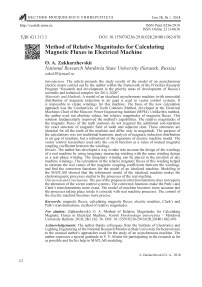Method of relative magnitudes for calculating magnetic fluxes in electrical machine
Автор: Zakharzhevskii Oleg A.
Журнал: Инженерные технологии и системы @vestnik-mrsu
Рубрика: Машиностроение
Статья в выпуске: 1, 2018 года.
Бесплатный доступ
Introduction. The article presents the study results of the model of an asynchronous electric motor carried out by the author within the framework of the Priorities Research Program "Research and development in the priority areas of development of Russia's scientific and technical complex for 2014-2020". Materials and Methods. A model of an idealized asynchronous machine (with sinusoidal distribution of magnetic induction in air gap) is used in vector control systems. It is impossible to create windings for this machine. The basis of the new calculation approach was the Conductivity of Teeth Contours Method, developed at the Electrical Machines Chair of the Moscow Power Engineering Institute (MPEI). Unlike this method, the author used not absolute values, but relative magnitudes of magnetic fluxes. This solution fundamentally improved the method's capabilities. The relative magnitudes of the magnetic fluxes of the teeth contours do not required the additional consideration for exact structure of magnetic field of tooth and adjacent slots. These structures are identical for all the teeth of the machine and differ only in magnitude. The purpose of the calculations was not traditional harmonic analysis of magnetic induction distribution in air gap of machine, but a refinement of the equations of electric machine model. The vector control researchers used only the cos(6) function as a value of mutual magnetic coupling coefficient between the windings. Results. The author has developed a way to take into account the design of the windings of a real machine by using imaginary measuring winding with the same winding design as a real phase winding. The imaginary winding can be placed in the position of any machine windings. The calculation of the relative magnetic fluxes of this winding helped to estimate the real values of the magnetic coupling coefficients between the windings, and find the correction functions for the model of an idealized machine. Modeling in the MATLAB showed that the refinement model of the idealized machine makes the electromagnetic processes similar to the processes of the real machine. Discussion and Conclusions. The use of the proposed correction functions does not require the alteration of the vector control systems. The correction functions make the Park's and Clark's transformations more exact. The model of machine becomes more accurate and the processes taking place inside it coincide with real machine processes. The control of the electric machine becomes more precise.
Magnetic fluxes, calculating magnetic fluxes, electric machine, clark''s and park''s transformations, method of relative magnitudes
Короткий адрес: https://sciup.org/14720284
IDR: 14720284 | DOI: 10.15507/0236-2910.028.201801.062-076
Список литературы Method of relative magnitudes for calculating magnetic fluxes in electrical machine
- Blondel A. Notes sur la theorie elementaire des appareils a champ tournant. La Lumiere Electrique. 1893; 50:605-616. (In French)
- Park R. Two reaction theory of synchronous machines. Transactions AIEE. 1929; 48:716-730. Available at: http://ieeexplore.ieee.org/document/5055275
- Gorev A. A. . Trudy Leningrad-skogo politekhnicheskogo instituta = Works of Leningrad Politechnical Institute. 1936; 5:32-19. (In Russ.)
- Ansari A. A., Deshpande D. M. Mathematical model of asynchronous machine in MATLAB Simu-link. International Journal of Engineering Science and Technology. 2010; 2(5):1260-1267.
- Zakharzhevskii O. A., Panfilov S. A. Display of the structure of windings in the model of the asynchronous machine. Collected Scientific Papers SWorld. 2013; 8(2):36-39.
- Zakharzhevskii O. A., Afonin V. V. Simulation of acceleration asinchronous machine. Collected Scientific Papers SWorld. 2013; 7(4):9-13.
- Zakharzhevskii O. A., Afonin V. V. . Elektronnoye modelirovaniye = Electronic Modeling. 2014; 36(4):101-116. Available at: http://dspace.nbuv.gov.ua/handle/123456789/101017 (In Russ.)
- Luo X., Liao Y., Toliyat H. A., Lipo T. A. Multiple coupled circuit modeling of induction machines. IEEE Transactions Industrial Applications. 1995; 31(2):311-317.
- Akbari H., Meshgin-Kelk H., Milimonfared J. Extension of winding function theory for radial and axial nonuniform air-gap in salient pole synchronous machines. Progress in Electromagnetics Research. 2011; 114:407-428. Available at: http://www.jpier.org/PIER/pier114/25.11011201.pdf
- Qi L., Fan T., Wen X. Armature-reaction magnetic field analysis for interior permanent magnet motor based on winding function theory. IEEE Transactions on Magnetics. 2013; 49(3):1193-1201 DOI: 10.1109/TMAG.2012.2224358
- Zakharzhevskii O. A., Afonin V. V. Patent RU. No. 2557071, IPC H02P 21/00 of 25.02.2013. The Method of vector control of speed of three-phase machine. Patentee: Mordovia State University. (In Russ.) Mechanical engineering 75 ВЕСТНИК МОРДОВСКОГО УНИВЕРСИТЕТА Том 28, № 1. 2018
- Zakharzhevskii O. A., Afonin V. V. . Vestnik Yuzhno-Uralskogo gosudarstvennogo universiteta. Seriya: Energetika = Bulletin of South Ural State University. Series Power Engineering. 2015; 15(4):74-82 (In Russ.)
- Lubin T., Hamiti T., Razik H., Rezzoug A. Comparison between finite-element analysis and winding function theory for inductances and torque calculation of a synchronous reluctance machine. IEEE Transactions on Magnetics. 2007; 43(8):3406-3410 DOI: 10.1109/TMAG.2007.900404
- Tessarolo A. Accurate computation of multiphase synchronous machine inductances based on winding function theory. IEEE Transactions on Energy Conversion. 2012; 27(4):895-904. DOI: 10.1109/TEC.2012.2219050
- Kyung-Tae K., Jun-Kyu P., Jin H., Byeong-Woo K. Comparison of the fault characteristics of IPM-type and SPM-type BLDC motors under inter-turn fault conditions using winding function theory. IEEE Transactions on Industry Applications. 2014; 50(2):986-994 DOI: 10.1109/TIA.2013.2272911
- Bossio G., Angelo C. D., Solsona J., Garcia G., Valla M. I. A 2-D model of the induction machine: An extension of the modified winding function approach. IEEE Transactions on Energy Conversion. 2004: 19(1):144-150.
- Serrano-Iribarnegaray L., Cruz-Romero P., Gomez-Exposito A. Critical review of the modified winding function theory. Progress in Electromagnetics Research. 2013; 133:515-534.


